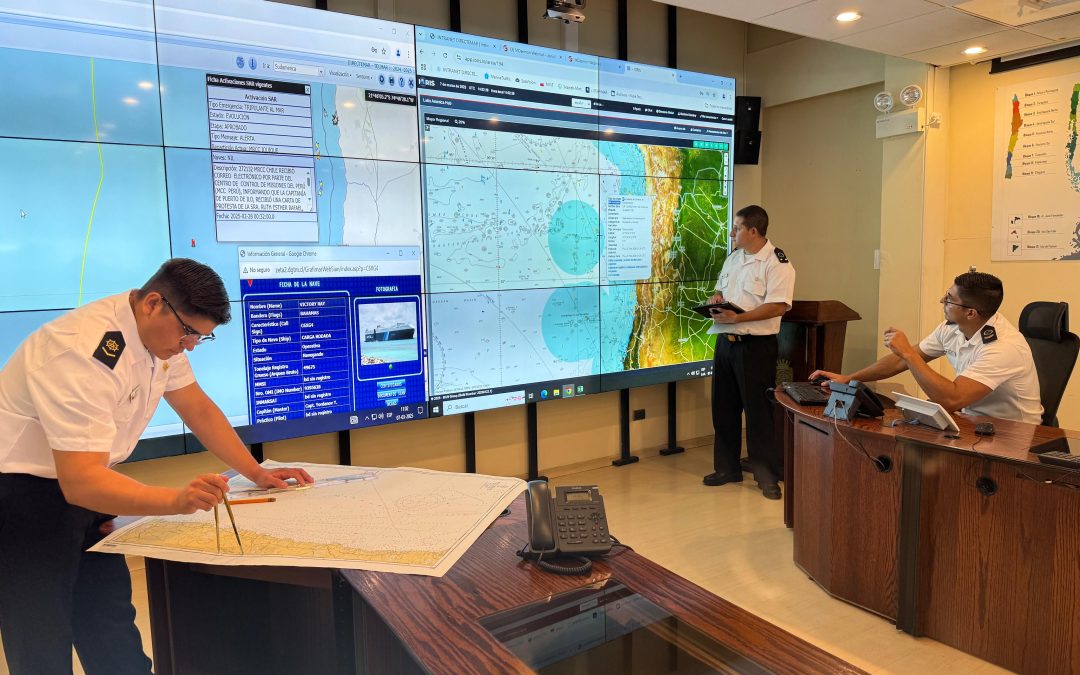In an era marked by complex maritime threats and heightened regional interdependence, the capacity for real-time coordination across agencies and borders is essential. Exercises such as “REGEX LATAM SEGMAREX” are more than training—they are operational simulations that test systems, validate procedures, and reinforce partnerships.
The image featured in this article was submitted by MRCC Chile as part of a photo contest launched by CRIMARIO last February. The initiative was designed to highlight the role of the IORIS platform in facilitating cooperation, coordination, and communication among maritime actors. Far from symbolic, the photo captures a live operational setting that reflects how IORIS strengthens maritime situational awareness and promotes secure, cross-border collaboration.
This interview with Sargento 1° Javier Bahamonde Ramírez, Supervisor General NCAGS, Chilean Nany, provides insight into the operational reality behind the photo—a moment where coordination, professionalism, and technology intersect in service of maritime safety.
Can you describe the situation taking place when the photo was captured?
The photo was taken during the “REGEX LATAM SEGMAREX” regional maritime exercise. It shows the MRCC Chile situation room in full operation, managing a Search and Rescue (SAR) case while actively exchanging critical information with Latin American partner countries via the IORIS platform. The image reflects a high-functioning coordination centre executing its mandate in a simulated, but realistic, emergency context.
How does this photo demonstrate the importance of information sharing at sea?
The photo visually demonstrates how timely access to multi-source data—shared through platforms like IORIS—enhances the speed and accuracy of maritime decision-making. It underscores the operational need for interoperability, disciplined communication protocols, and structured coordination mechanisms, especially in cross-border SAR operations. It is a clear reminder that safety at sea hinges not just on assets, but on informed and connected personnel.
Why do you feel this image is a strong representation of IORIS in action?
The image captures the essence of IORIS in practice—multiple professionals with defined responsibilities collaborating through a secure, shared platform. It illustrates how the system enables the real-time integration of data, clarity of roles, and cross-institutional synergy. IORIS is not a passive tool—it is an active enabler of maritime coordination, and this photograph is a compelling representation of that capability.
In the Chilean Navy since 2002, Sargento 1° Javier Bahamonde Ramírez has been assigned since 2022 to the Directorate of Maritime Safety and Operations in Valparaíso. Currently stationed at both the Naval Maritime Traffic Control Center and MRCC Chile, he is directly involved in maritime incident coordination, vessel monitoring, and inter-agency communication. His operational and technical knowledge supports Chile’s growing role in regional maritime safety.
ABOUT MRCC Chile
The Maritime Rescue Coordination Centre Chile (MRCC Chile) is the national authority responsible for coordinating maritime search and rescue operations within Chile’s internationally designated Search and Rescue Region (SRR). Operating under the Directorate General of the Maritime Territory and Merchant Marine (DIRECTEMAR), MRCC Chile meets the highest international standards set by the International Maritime Organization (IMO).
Its core mission is to preserve life at sea through the activation and coordination of naval, air, and ground resources. Beyond its SAR function, MRCC Chile plays a critical role in maritime surveillance, data exchange, and incident prevention, acting as a key strategic node in the South Pacific’s maritime safety architect

